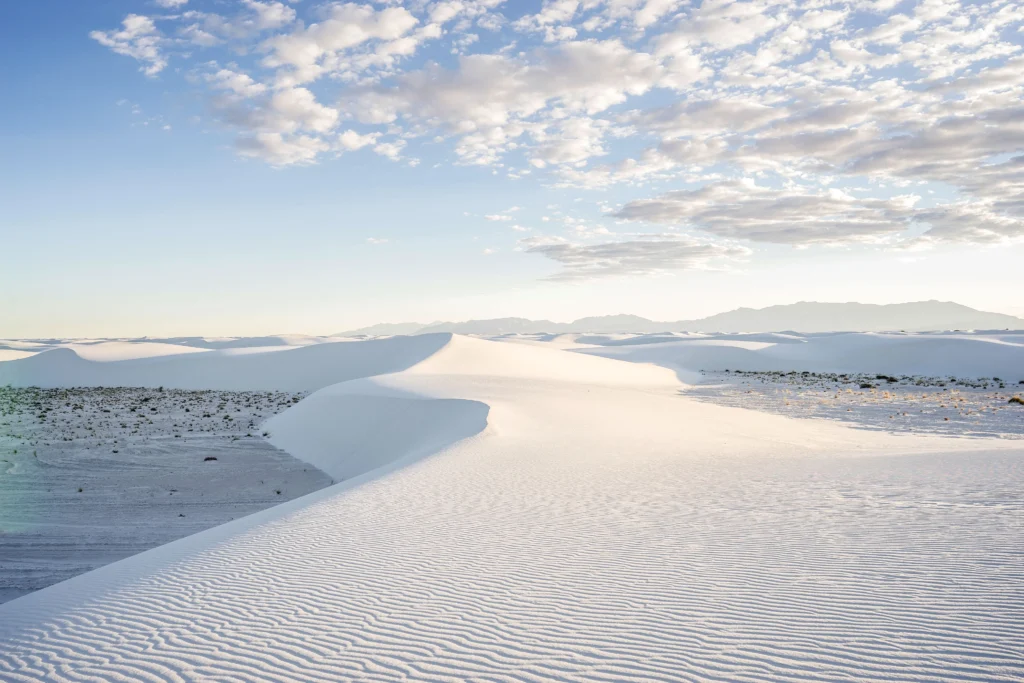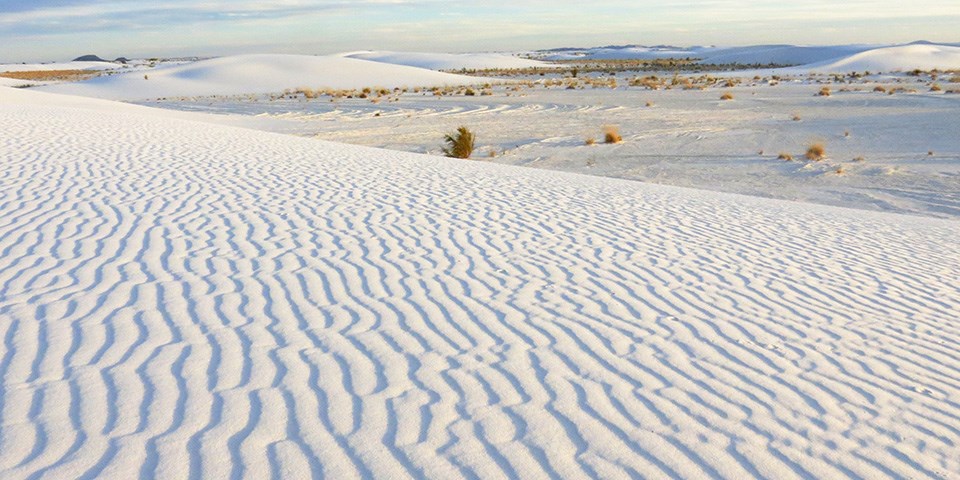Nestled in the Tularosa Basin of southern New Mexico, White Sands National Monument is a breathtaking landscape of rolling white gypsum dunes that seem to stretch endlessly into the horizon. Covering over 275 square miles, the dunes of White Sands are a geologic wonder that has intrigued scientists and visitors alike for centuries.
The gypsum dunes that make up White Sands National Monument are unique in the world, and studying their geology provides valuable insights into the complex and fascinating processes that shape our planet’s surface. The story of the monument’s geologic history is one of ancient seas, tectonic upheavals, and the ceaseless work of wind and water.
In this article, we will explore the geology of White Sands National Monument, including the formation and composition of the gypsum dunes, the area’s unique geological features and formations, and the ways in which the area’s geology has influenced the evolution of plant and animal life. We will also examine the human history of the area and how people have interacted with and been shaped by the unique geology of White Sands. Join us as we take a journey through time and explore the fascinating geological wonders of White Sands National Monument.

Contents
Formation and composition of the gypsum dunes
The gypsum dunes at White Sands National Monument are formed from pure white gypsum sand, which is unique to the region. Gypsum is a common mineral that is formed when seawater evaporates, leaving behind a deposit of calcium sulfate.
The formation of the White Sands dunes began millions of years ago, when the area was covered by a shallow sea. Over time, the sea evaporated and the gypsum deposits were left behind. As tectonic activity caused the land to rise, the gypsum deposits were exposed to wind and weathering, eventually forming the dunes that we see today.
The gypsum sand that makes up the dunes is highly unique in terms of its composition and properties. Gypsum is a soft mineral with a hardness of 2 on the Mohs scale, which means that it can be easily crushed and broken down into small particles. This softness is what allows the sand to be easily blown and shaped by the wind.
Additionally, gypsum has a unique ability to absorb and release water. This means that the gypsum sand at White Sands National Monument is able to hold onto moisture, even in the desert environment where rainfall is scarce. The ability of the sand to hold onto water also means that it stays cool to the touch, even in the hot sun.
The pure white color of the gypsum sand is another unique feature of the dunes. The white color is caused by the high levels of purity of the gypsum sand, which reflects and refracts light in a way that gives it its distinctive color.
Overall, the formation and composition of the gypsum dunes at White Sands National Monument are highly unique and fascinating, and studying them provides valuable insights into the complex geologic processes that have shaped the region over millions of years.
:max_bytes(150000):strip_icc()/white-sands-national-park-new-mexico-01-WHITESANDS0322-dfd47748a17f46d382986fb4bcc30664.jpg)
Geologic history of the area
The area around White Sands National Monument has a long and complex geologic history that dates back millions of years. The region was once covered by a shallow sea, known as the Permian Sea, which was home to a diverse array of marine life. Over time, the sea evaporated and the gypsum deposits were left behind.
As tectonic activity caused the land to rise, the gypsum deposits were exposed to the elements, including wind and weathering, eventually forming the dunes that we see today. The movement of the Earth’s crust also created a number of other unique geological features in the region, including sinkholes and playa lakes.
In more recent geologic history, the region has experienced a number of significant climatic shifts that have influenced the landscape. During the last ice age, for example, the region was much cooler and wetter than it is today, and there were large lakes and rivers in the area. As the climate changed and the ice retreated, the landscape was reshaped once again by wind and water.
Today, the area surrounding White Sands National Monument is characterized by a desert climate, with hot, dry summers and cool winters. The region is also prone to frequent dust storms and high winds, which play an important role in shaping the gypsum dunes over time.
Overall, the geologic history of the area surrounding White Sands National Monument is complex and fascinating, with a long and diverse history that has shaped the landscape in unique and interesting ways. By studying the geology of the region, scientists can gain valuable insights into the processes that have shaped our planet over millions of years.

Unique geological features and formations
Here are some unique geological features and formations that can be found in and around White Sands National Monument:
- Gypsum dunes: The most famous geological feature at White Sands National Monument is, of course, the gypsum dunes themselves. These dunes are made up of pure white gypsum sand and are constantly shifting and changing shape due to wind and weathering.
- Playas: Playas are flat, dry lakebeds that can be found throughout the region. These unique geological features are formed when the land dips below the water table and forms a depression, which then fills with water during periods of heavy rain. When the water evaporates, it leaves behind a flat, barren landscape.
- Sinkholes: Sinkholes are depressions in the ground that form when the land above an underground cave or other void collapses. These features can be found throughout the region and are often associated with the presence of gypsum.
- Alkali flats: Alkali flats are dry lakebeds that are characterized by a white, crusty layer of salt and other minerals. These features can be found throughout the region and are formed when water evaporates, leaving behind a layer of salt and other minerals.
- Sandstone cliffs: Although the gypsum dunes are the most famous geological feature at White Sands National Monument, there are also a number of sandstone cliffs and formations in the area. These features are the result of erosion and weathering over millions of years.
Overall, the unique geological features and formations at White Sands National Monument provide a fascinating glimpse into the complex processes that have shaped the region over millions of years. From the shifting gypsum dunes to the barren playas and alkali flats, each of these features tells a story about the forces that have shaped our planet over time.

Plant and animal life in the gypsum dunes
Due to the harsh environment of the gypsum dunes, plant and animal life in the region is relatively sparse and adapted to survive in these unique conditions.
Plant Life: Despite the harsh conditions, a variety of plant species are able to survive in the gypsum dunes. The most common plant species found in the region include grasses, cacti, and a variety of other small flowering plants. These plants are able to survive in the gypsum soil due to their ability to conserve water and tolerate high levels of salt.
Animal Life: Although the gypsum dunes may seem like a barren landscape, a number of animal species are able to thrive in the region. Some of the most common animal species found in the area include rodents, lizards, and snakes. These animals are able to survive in the gypsum dunes due to their ability to burrow into the sand and seek shelter from the harsh sun and wind. Additionally, a variety of bird species are also able to survive in the region, including roadrunners, hawks, and owls.
Despite the relatively limited amount of plant and animal life in the gypsum dunes, the region is still an important habitat for a variety of species. The unique conditions of the dunes provide an important ecosystem that supports a diverse array of plant and animal life, and is a valuable resource for scientists studying the complex processes that shape our planet.

Conclusion
In conclusion, the White Sands National Monument in New Mexico, USA is a truly unique geological wonder that offers visitors the chance to witness firsthand the complex processes that have shaped our planet over millions of years. From the shifting gypsum dunes to the barren playas and alkali flats, each of these features tells a story about the forces that have shaped the region and continue to shape our planet today.
Despite the harsh conditions, a variety of plant and animal species have adapted to survive in this unique environment, making the White Sands National Monument an important ecosystem and a valuable resource for scientific study. Whether you’re interested in geology, biology, or simply the beauty of the natural world, the White Sands National Monument offers something for everyone and is a truly unforgettable destination.


































